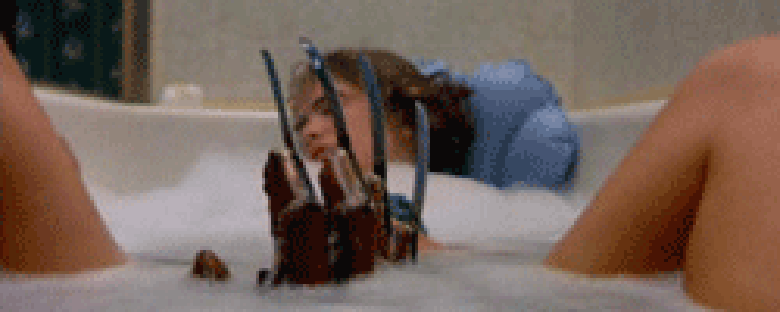Reviews
Wes Craven
USA, 1984
Credits
Review by Leo Goldsmith
Posted on 20 October 2006
Source New Line Home Video DVD
Related articles
Features: 31 Days of Horror
Features: Neverending Nightmares: A Retrospective of Friday the 13th and A Nightmare on Elm Street
”Screw sleep!”
There’s something about Nancy Thompson’s cry, midway through A Nightmare on Elm Street, that has just the right air of hysterical teenage petulance. Out of context, one might assume she was an ordinary high-school girl, given to late-night partying and backseat romps with her jock boyfriend, objecting to being sent to bed without supper or being mothered into getting an early night. But, of course, Nancy isn’t merely stamping her feet at being banned from watching the late-late show; she’s trying to keep from being slashed to death by the ghost of a long-dead child murderer who lives in her dreams and wears a jury-rigged razor-glove and a funny hat. Such are the tribulations of the girl next door—at least in horror movies of the 1980s.
Like many filmmakers working in genres maudits like horror or Westerns, Wes Craven was never, until recently, rated very highly for his wit and intelligence. It took a good quarter-century of work and a very colloquially “meta” film called Scream (made two years after his still more “meta” film, New Nightmare) for many to realize that Craven was actually quite self-conscious, cinematically thoughtful, and even rather funny. Scream proved a number of things about Craven to critics and audiences alike: that he knew a great deal about horror films, and how and why they work; that he knew how to manipulate and recycle generic mainstays and to use them to great effect in spite of their conventionality; and that all of this can be highly profitable and can spawn a seemingly endless chain of sequels. But in fact, Craven had already proved this with A Nightmare on Elm Street, a film that, when viewed today, may strike one as among the most originally unoriginal films ever made.
Craven knew the formula well. After The Last House on the Left and The Hills Have Eyes, two monumentally unpleasant horror films that prey upon the social anxieties of the 1970s, Craven took up the mantle (and the playbook) of John Carpenter and Sean Cunningham. Their Halloween and Friday the 13th soon became the prototypes of the New Teen Horror that Craven effortlessly synthesizes in the original Nightmare: a gaggle of horny teenagers pitted against an iconic, semi-supernatural bogeyman. Toss in all the usual hang-ups about youth and suburban life — drugs, sex, and irresponsible, late-night behavior — and this cycle of films amounts to a critique of middle-class suburbia as arguably piquant as Hitchcock’s Shadow of a Doubt, exploiting the conservative jitters about animalistic urges lurking beneath the placid surface of the American Dream.
What’s so clever about Craven’s variation on teen-horror is what now seems so obvious about it: A Nightmare on Elm Street takes all of this fear of unmanageable desires and makes it explicitly, even bluntly Freudian. “What the hell are dreams anyway?” asks Nancy’s schnapps-swilling mother of the local sleep-disorder specialist. “Mysteries,” he replies, rather unconvincingly. “Incredible body hocus-pocus. The truth is we still don’t know what they are… or where they come from.” In this case, Craven knows exactly where they come from: puberty. All that pent-up sexual energy — personified here by Johnny Depp climbing through Nancy’s window in pajama pants and a cut-off t-shirt — is the sort of dangerous dream-fodder that will eventually get you killed in a horror movie. Witness the punishment visited upon Laurie’s slutty babysitter colleagues in Halloween, and the relative safety for the chaste Laurie herself. In Nightmare, Craven retains this moralistic schema with a slight variation: instead of a materialized super-ego (like Michael Myers) who comes to punish all id-like lust of the teens, Fred Krueger is a manifestation of the dream-world itself, returning to punish the very desires from which it supposedly arises. Krueger’s first victim (“Tiiiiiiiinaaaaaa…”) is slaughtered in a bloody bedroom bonanza following some voluble lovemaking with her boyfriend (improbably called “Rod”), and though Nancy is a good girl in this regard, Freddy attempts to invade her dreams to become her “boyfriend,” tongue-kissing her through her telephone. (This becomes doubly evident in the moments when the film cribs from a very similar [though less 80s] film about the terrors of promiscuity, Polanski’s Repulsion.) In this light, the death scene of Depp’s sexually frustrated Glenn — sucked into the middle of his mattress and then spit out into a ceiling-squirting geyser of blood — is the ultimate wet dream.
If the Freudian sledgehammer that is Fred Krueger functions as a return of the repressed, it is abundantly clear that he symbolizes something collective and not simply personally psychological. It is — as these things usually are — the fault of the parents themselves, who years ago burned the evil boiler-room child-murderer to death in an angry mob obviously redolent of a Frankenstein movie. “He’s dead, honey, because Mommy killed him,” Nancy’s boozy mother says soothingly. But in horror movies, where, by definition, things killed, suppressed, and submerged are always returning to terrorize us, such an explanation is hardly reassuring. This repression and return has, after all, formed Freddy Krueger’s (and Craven’s) legacy, with his undying iconicity and easily recognized green-and-red-striped branding, sustainable through innumerable sequels, rip-offs, homages, and — almost inevitably — remakes.
We don’t do comments anymore, but you may contact us here or find us on Twitter or Facebook.



